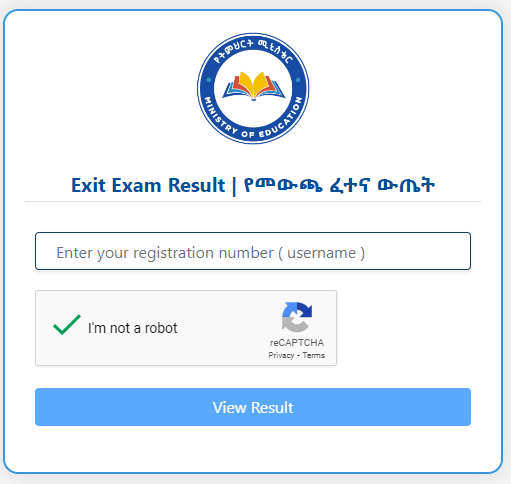Exit Exam Result 2017 Ethernet.edu.et Result
Exit Exam Result 2017 Ethernet.edu.et Result
The results of the 2017 Exit Exam have become a central topic in discussions about the state of education in Ethiopia. This national assessment captured the attention of students, universities, policymakers, and the general public. As Ethiopia’s education system evolves, university exit exams play an increasingly critical role in ensuring quality education and preparing graduates for the workforce.
This blog explores the Ethiopian education system, the role of universities, and the importance of the exit exam. It focuses particularly on the 2017 results and what they reveal about the challenges and opportunities in higher education.
Overview of the Ethiopian Education System
Ethiopia’s education system is structured into three main levels: primary, secondary, and tertiary (higher education). Over the last two decades, significant progress has been made in improving access, building more schools, recruiting teachers, and implementing quality reforms. The Ministry of Education (MoE) is the main authority overseeing educational policies and evaluating performance at all levels.
At the university level, Ethiopia follows a massification policy, aiming to enroll large numbers of students in public institutions across the country. As of 2024, over 50 public universities and numerous private colleges offer undergraduate and graduate programs. However, this rapid growth has led to challenges in quality assurance, staff development, infrastructure, and employability of graduates.
The Role of Ethiopian Universities
Universities in Ethiopia are central to national development. They are key to producing skilled labor, conducting research, and engaging with local communities through outreach programs. Prominent institutions include Addis Ababa University, Bahir Dar University, Jimma University, and Hawassa University.
Core Objectives of Ethiopian Universities:
- Delivering high-quality education across diverse academic fields
- Conducting research for national development
- Promoting community development through extension services
Despite these goals, universities face criticism for producing graduates who are not fully prepared for the job market. In response, the Ministry of Education introduced the national Exit Exam as a means of quality control.
Understanding the University Exit Exam
The Ethiopian University Exit Exam is a mandatory national test for final-year students in selected disciplines. It serves to:
- Evaluate students’ academic knowledge and professional competence
- Standardize graduate output from all universities
- Ensure quality and consistency in higher education
Initially launched for health sciences, engineering, and education fields, the Exit Exam has since expanded to business, agriculture, and natural sciences. Students must pass this exam to receive their official degree certification, making it a high-stakes academic milestone.
Highlights from the 2017 Exit Exam Results
The 2017 Exit Exam results provided critical insights into the state of higher education in Ethiopia. According to the Ministry of Education:
- Over 100,000 students took the exam nationwide
- The national average pass rate was about 46%
- Established universities had significantly higher pass rates than newer ones
- Health and engineering fields performed better than business and education
- Female students continued to score lower than male students, although improvements were noted
These results were both eye-opening and concerning, revealing major gaps and challenges within the system.
Implications of the 2017 Exit Exam Results
1. Quality Gaps Between Universities
Older universities with better infrastructure, faculty, and resources performed much better than newer institutions, particularly those in remote regions. This highlights systemic inequality in the education sector.
2. Curriculum and Teaching Standards
Many students faced exam questions on topics not adequately covered in their coursework. This reflects inconsistencies in curriculum delivery across universities and a misalignment between teaching and assessment.
3. Student Preparedness
Concerns arose over students’ study habits and preparedness. Critics pointed out an over-reliance on memorization and inadequate academic support systems, especially in overcrowded programs.
4. Gender Disparity
Despite increasing female enrollment, gender disparities in performance persist due to social pressures, domestic responsibilities, and limited support services.
Public Reaction and Government Response
The 2017 results triggered public debates, with some praising the MoE for upholding academic standards while others criticized the test for being too rigid and unfair. Student protests in certain areas called for re-evaluation and reform.
MoE’s Response Included:
- Revising the exit exam’s structure and content
- Training university lecturers to improve teaching quality
- Introducing remedial and bridging programs
- Setting up regional exam centers for equitable access
Future Directions for the Exit Exam
The 2017 results serve as a wake-up call and a foundation for reform. A shift toward quality education, fair assessment, and student-centered learning is essential.
Recommendations:
- Improve Teaching Quality: Invest in faculty training, use modern teaching methods, and promote continuous professional development.
- Standardize Curriculum: Ensure all universities follow a unified curriculum aligned with exit exam requirements.
- Enhance Student Support: Provide tutoring, mental health services, and academic advising.
- Upgrade Educational Infrastructure: Equip institutions with labs, libraries, and digital tools.
- Promote Equity and Inclusion: Support female and disadvantaged students through scholarships and mentorship programs.
Conclusion
The 2017 Exit Exam was more than a test—it was a reflection of Ethiopia’s higher education challenges and potential. While the results revealed significant weaknesses, they also offered a chance for meaningful reform. With coordinated efforts from the government, universities, students, and communities, Ethiopia can build a more robust, fair, and high-performing education system.
By learning from 2017 and implementing thoughtful reforms, Ethiopia can transform its universities into centers of excellence that produce graduates ready to contribute meaningfully to national development.






